E-Waste Recycling Glossary: 60 Terms for Recycling Enthusiasts!
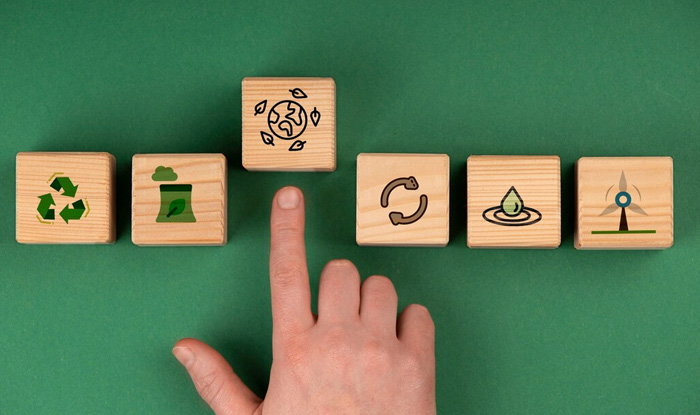
Image Source: FreePik
E-waste recycling is a complicated problem of massive proportions. From devices intentionally designed to fail every few years to recycling systems that do not have the capacity or the resources to handle multiple million tons of e-waste every year — it’s a problem that we keep adding to constantly.
But as Mother Nature refuses to give up, so do eco-conscious consumers and ESG-minded businesses.
Every day we come across environmental activists who continue to raise awareness, regular people who want to learn how to handle their e-waste responsibly, and scientists and experts who work on innovative technologies to solve the e-waste crisis in the most planet-positive way possible.
If you also want to join this fight against e-waste, start by learning the language it comes in. In this recycling guide, we cover 60 critical terms, concepts, and names (of institutes, agencies, and organizations) you’ll often encounter and hear about when discussing e-waste.
Here they are — in alphabetical order, so you don’t associate priority where none is intended.
1. Advanced Recovery Fee
It is a legislative fee added to the final price of certain products to discourage improper disposal and to fund e-waste recycling and recovery programs. Consumers pay these fees when they buy a new or refurbished electronic product. Retailers then deposit these fees back to local governments to support buy-back programs, waste management recycling bins, and other e-waste recycling initiatives.
2. Alkaline Batteries
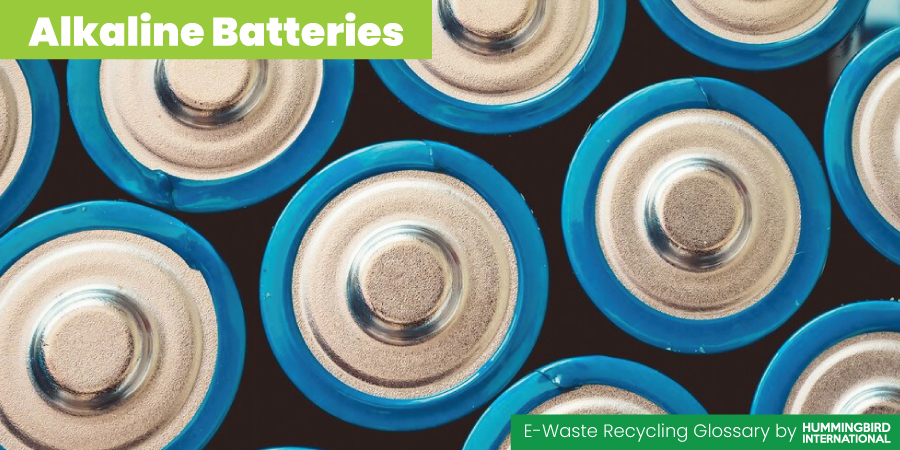
Alkaline batteries are disposable batteries that contain zinc and manganese dioxide as electrodes. You can find them in several household items such as digital cameras, flashlights, remote controls, door locks, etc.
Alkaline batteries contain non-toxic materials and that’s why they aren’t classified as hazardous waste by the EPA. Yet, they aren’t rechargeable batteries, and any excessive use can result in increased levels of e-waste.
Plus, spent alkaline batteries should be sent for recycling as they’re almost 100% recoverable.
3. Biosphere
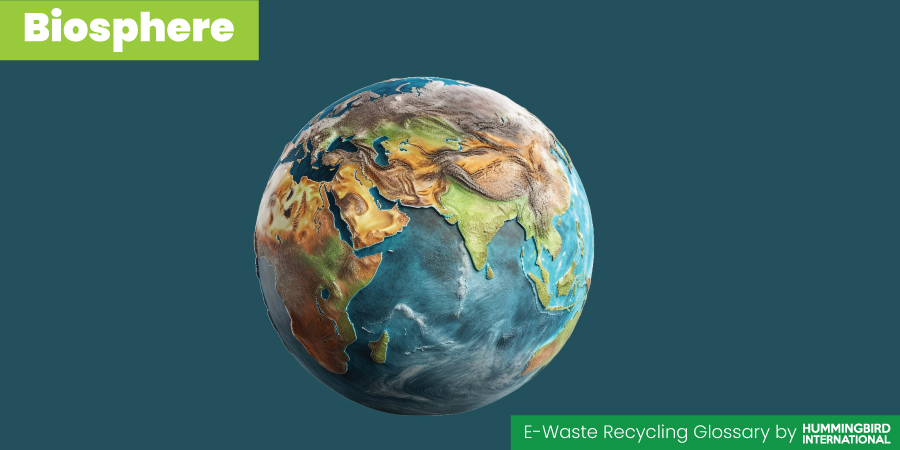
This is the part of the earth where life can create and sustain itself. It’s a limited zone on the surface of the earth where soil, water, and air come together to support life.
Toxic electronic waste — if left to decompose on earth — can harm the biosphere by polluting its soil, water, and air streams and thus damaging human, animal, and plant life.
4. Buyback Programs
Manufacturers and retailers of electric and electronic goods set up buyback or takeback programs where consumers can return their spent/discarded tech devices for proper e-waste recycling.
Brands like BestBuy, Dell, Apple, and more offer these programs.
5. Carbon Footprint
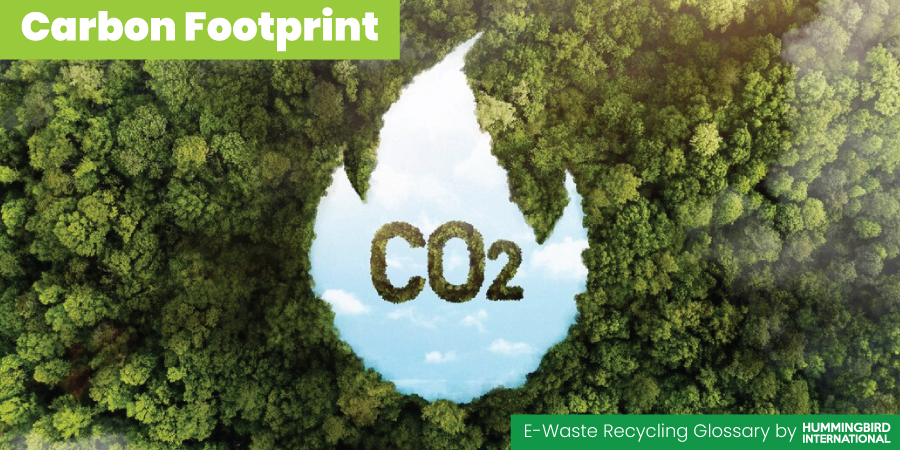
A carbon footprint is the measure of the total amount of greenhouse gas emissions that our actions and activities cause. Each of us leaves a carbon footprint when we drive our car, use a lawnmower, or take an airplane flight.
In the US, the average carbon footprint of a person is 16 tons, one of the highest in the world. For comparison, the global average is about 4 tons only.
6. Carcinogens
Carcinogens are substances and agents that have the potential to cause cancer in humans. Common carcinogens found in electronic waste include lead, mercury, arsenic, chromium, flame retardants, and various forms of silicon, among others.
According to a 2022 study published in the National Library of Medicine, arsenic and chromium “were the most strongly associated with cancer risks.”
7. Certificate Of Destruction
It’s a certificate that an e-waste recycler issues after a hard drive disposal process, confirming the data’s complete deletion and destruction. Data destruction is a must in responsible e-waste recycling as improper handling can result in cyber security leaks and breaches.
8. Chain Of Custody
In information technology asset disposal, chain of custody refers to the process that documents where every single electronic item is throughout the various stages of recycling — from custody to transfer, then analysis and disposal.
9. Circuit Board
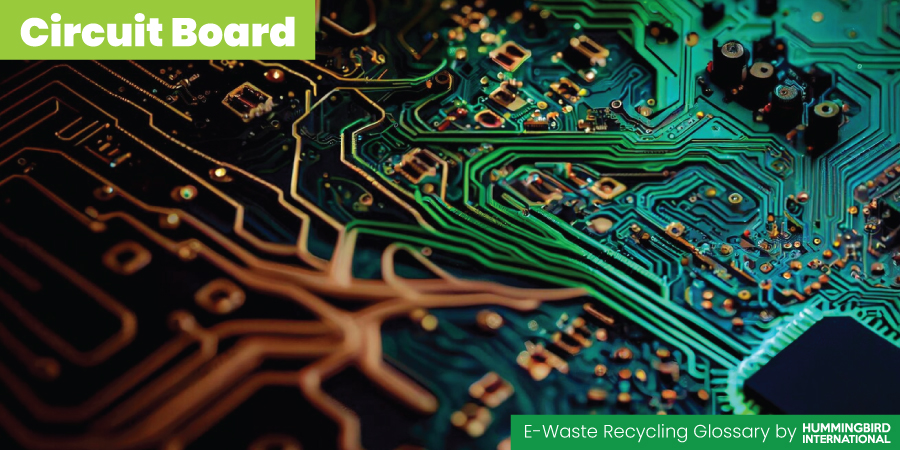
A circuit board, also called a printed circuit board (PCB), is a flat piece of material that holds and supports electronic components on its surface and provides electrical connectivity between those components.
It’s through these electric currents that different components in an electronic device communicate with each other and work together. Without circuit boards, most electronic devices would not function properly or at all.
All modern electronic devices contain circuit boards, including computer motherboards, mobile phones, remote controllers, medical devices, LEDs, and more.
10. Circular Economy

Also known as closed-loop manufacturing, circular economy is an alternative economic model that challenges the way we manufacture, use, and discard products. In a circular economy, products, parts, and materials are designed for durability and recycling — with constant repairs, reuses, and recycling for as long as possible.
It works with a preventive mindset where the focus is on generating less and less waste, instead of dealing with the issue once the waste has reached a crushing limit.
11. Commingled Recyclables
Also referred to as single-stream recycling, it’s a recycling system that only requires one recycling bin and truck. The idea is that residents will pile all of their recyclables in a single bin at the curb, which will all be collected by a single truck to a material recovery facility (MRF), where the sorting will be handled by recycling workers.
It makes the waste management recycling process convenient for citizens, which in turn encourages more people to start recycling their electronics.
12. Conflict Minerals

These are precious raw materials and minerals that are extracted from conflict zones and often, directly or indirectly, cause even more violence, human rights abuses, forced labor, and child labor as well.
The international community has classified tin, tantalum, tungsten, and gold as conflict minerals to discourage their excessive mining and protect the communities that live in those regions.
Unfortunately, all of these minerals are found in our regular-use electronic devices (mobile phones, cars, capacitors, etc.).
When we manufacture or discard an electronic device improperly, we not only harm the environment but perpetuate the problem of conflict mining too.
13. Consumer Electronics
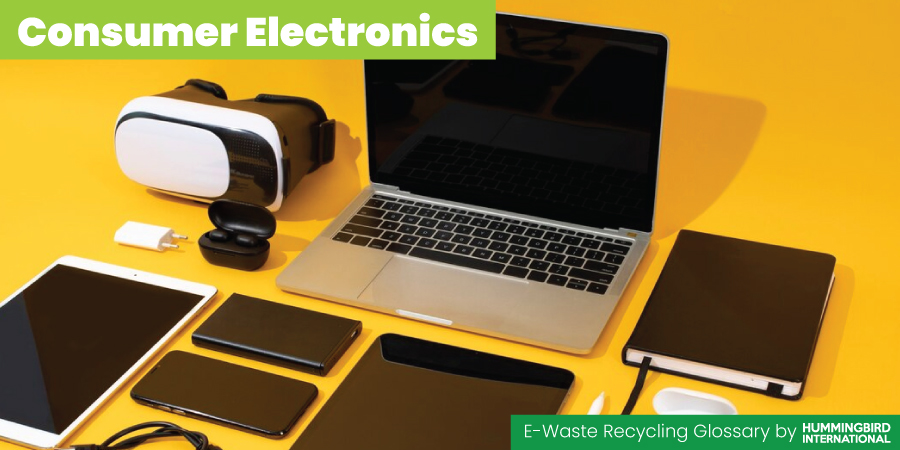
These are electronic products that are designed for our everyday use. Popular consumer electronics include smartphones, televisions, gaming consoles, etc.
In the U.S. an average consumer creates about 44 pounds of e-waste every year.
14. Cyber Security

Cyber security is the system of defense to protect computer systems and networks from malicious attacks.
When electronic waste isn’t recycled properly (a used laptop thrown into the bin), it can create avenues for criminals to gain access to sensitive data and cause issues to an individual’s, organization’s, or even country’s online or physical security.
15. Data Breach
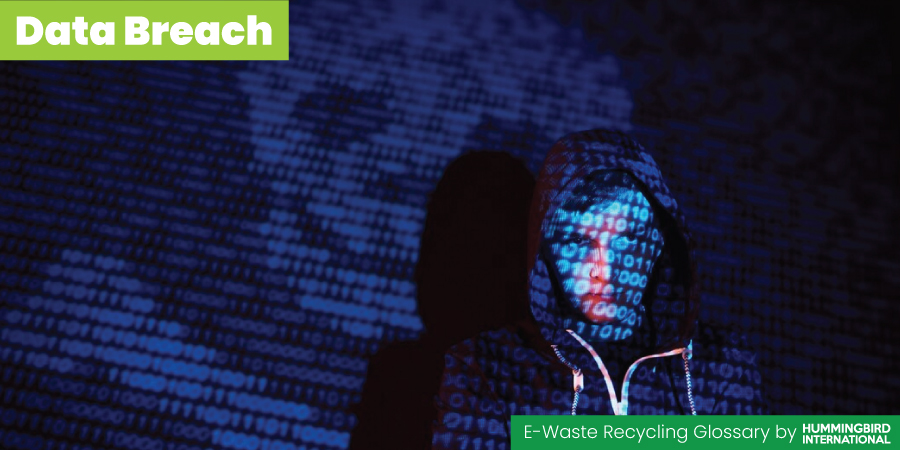
A data breach is a security violation, where information is stolen from a computer system or network without the owner or user’s knowledge or authorization.
Data breaches become extremely easy for hackers when we, as consumers, don’t engage in responsible recycling. Carelessly dumped smartphones, laptops, or hard drives become easy to get into by those who know what they are doing.
16. Data Destruction

It’s a process of destroying data on various storage and user devices to such an extent that it becomes impossible to retrieve or reclaim. Data destruction is an integral component of safe and legal electronic waste recycling.
17. Degaussing
This is a method of physically destroying the disks and drives by scrambling the magnetic sectors on them, as well as damaging their internal components like their read/write heads so the disks/drives are rendered completely useless.
18. Department of Environmental Conversion — DEC
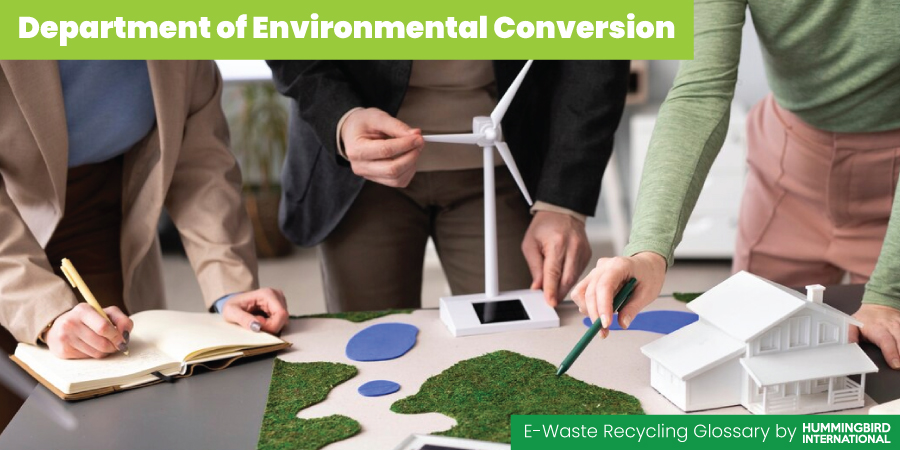
Various states in the US have their state-run departments for environmental protection and conversion. For different states, these departments are named differently but they perform similar tasks, of protecting the environment.
New York State, for example, has a DEC (Department of Environmental Conversion) whereas Pennsylvania has a DEP (Department of Environmental Protection).
19. Electric and Electronic Equipment — EEE

These are electric and electronic items, including digital cameras, mobile phones, televisions, copiers, and more that we use in our daily lives.
20. Electric and Electronic Tools — E&E Tools
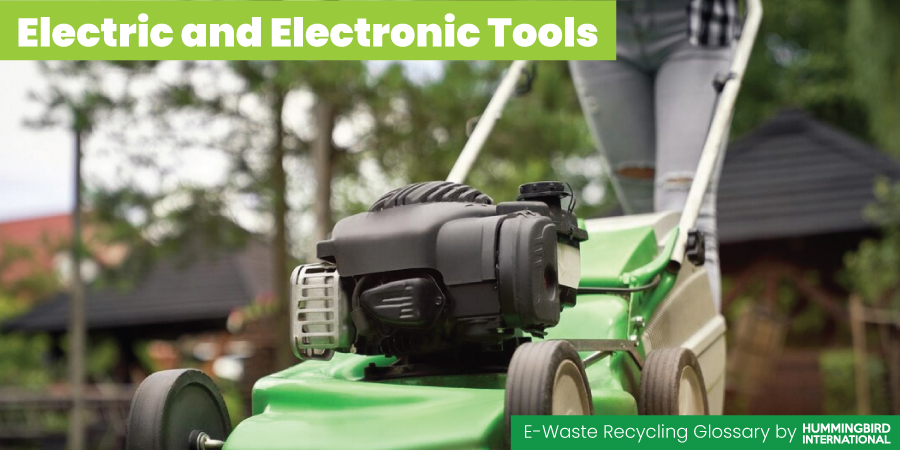
Tools such as electric drills, welding machines, lawnmowers, etc. that you need to process materials like wood or metal fall into this category. Similar to other forms of e-waste, they pose harm to the environment and must be dealt with responsibly.
21. Electronics Recycling
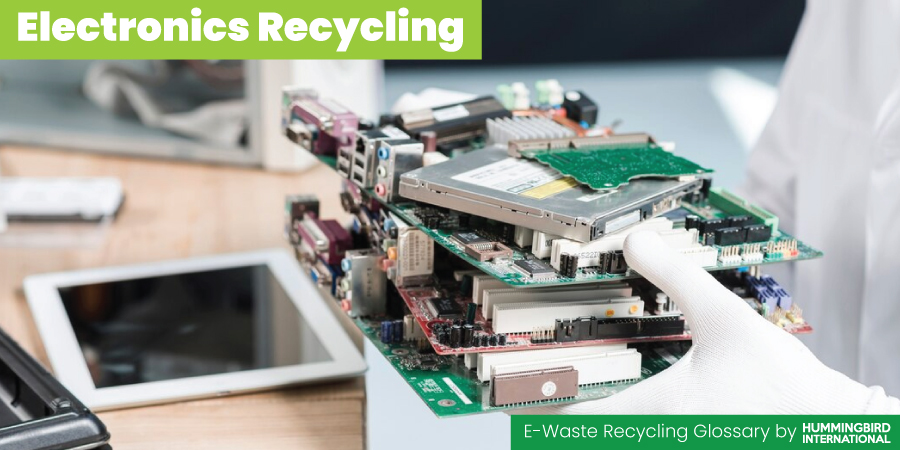
Electronics recycling is the process of collecting, sorting, and recycling used/discarded electronics. The aim is to recover precious metals and rare earth minerals from these devices.
Once extracted, these materials can be used to manufacture new products, without resorting to more mining.
22. Electronic Waste
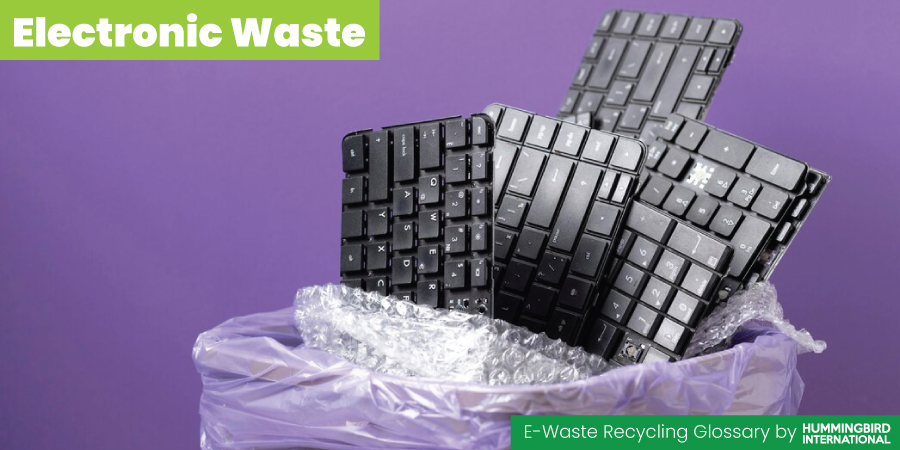
E-waste is the fastest-growing toxic waste stream in the world. It refers to electric and electronic products or materials that are old, have been discarded, or have reached their end of life.
Insufficient recycling and careless disposal of e-waste into landfills results in extreme harm to the environment where toxins released from these products leech into the soil, water, and air, harming all life on earth.
In 2021, the world generated 57.4 Mt (million metric tonnes) of e-waste.
23. End Of Life — EOL
It’s the point at which a device has reached the natural end of its life. It can no longer be used by anyone for any purpose. When a device reaches its end of life, it must be disposed of properly. Companies like ours, offer free e-waste recycling through which you can ensure that your EOL device has been disposed of in the safest, most eco-friendly way possible.
24. End Of Use — EOU
It’s the point at which an electronic device has reached its end of ‘regular’ or ‘original’ use. At this stage, the device can be donated, repurposed, or refurbished for further use or ‘reuse’.
25. Environmental, Social, and Governance — ESG
These are a set of standards that socially conscious investors use to measure a company’s behavior and performance on sustainability and ethical issues. These measures are then used to screen potential investments.
If a company performs poorly in these areas, socially conscious investors (or even consumers) may choose not to engage with them.
26. Environmental Footprint
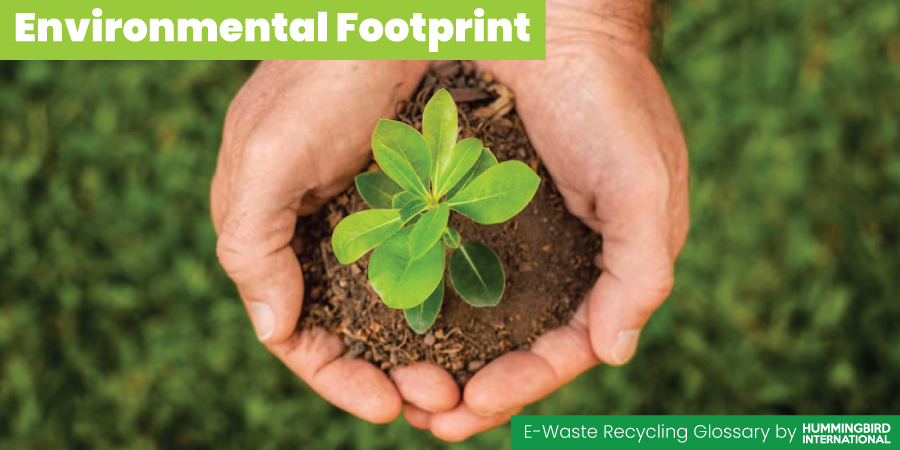
The environmental footprint is the impact of people or organizations on the environment and its resources. It’s a broad concept that covers multi-layered criteria, including carbon emissions, land use, and water scarcity.
The environmental footprint, also called the ecological footprint, considers the complete lifecycle of a company’s products and services and doesn’t rely on a single outcome.
27. Environmental Protection Agency — EPA
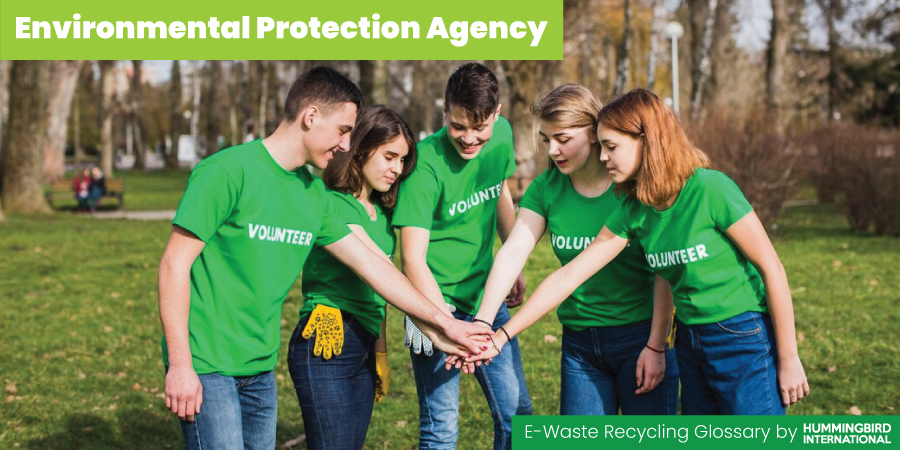
The EPA is an independent agency under the federal US government. Its mission is ‘to protect human health and the environment.’
It supports communities, individuals, businesses, and local, tribal, and state governments to enforce relevant laws regarding environmental protection.
28. E-Waste Pick-Up

Companies like Hummingbird International offer e-waste pickup services to individuals, businesses, non-profits, government organizations, etc., to make their e-waste recycling much easier and more convenient.
All you have to do is call us (888-392-7839) and schedule your pickup.
Our e-waste pickup services are free and available in Pennsylvania, New Jersey, and New York.
29. E-Waste Recyclers
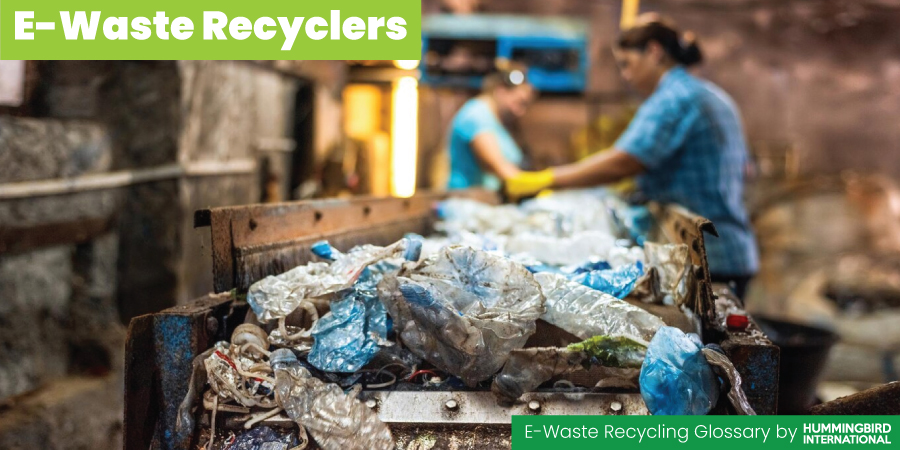
It’s a casual name given to electronic waste recycling companies that collect, sort, and recycle old and discarded electronic items. Legitimate e-waste recycling companies are licensed entities and operate in tandem with the relevant local, state, and federal laws and guidelines.
Before you engage with a waste management recycling company, verify their credentials and confirm if they employ trained experts who know how to handle the problem at every step.
30. Hazardous Waste
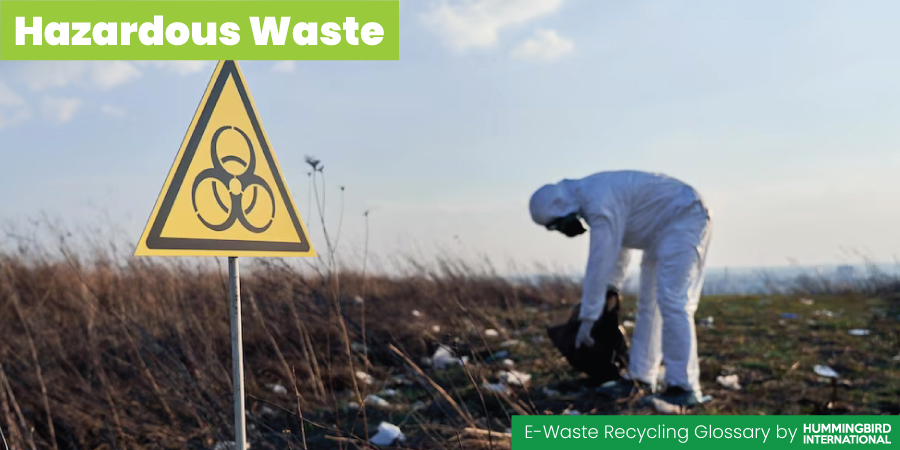
Waste that can substantially or potentially cause harm to public health or the environment is referred to as hazardous waste. It can be solid, liquid, or in the gas form. Based on the type of damage they can cause to human health or the environment, hazardous waste is classified into 5 categories:
- Toxic
- Chemically reactive
- Flammable
- Corrosive, and
- Radioactive.
E-waste is considered hazardous waste because it usually contains toxic materials — lead, mercury, and cadmium, for instance.
31. Heatless Elemental Recovery

When electronics need to be thrown away or sent for refurbishment, precious metals like gold and platinum need to be extracted from them. The typical processes use heat to do so but they are costly, time-consuming, and detrimental to the planet and people.
Heatless elemental recovery involves solutions like using acidic mixtures which can separate these valuable materials from a device’s plastic surface. These methods are gentler for the environment and release no toxic gasses to deal with.
32. HIPAA
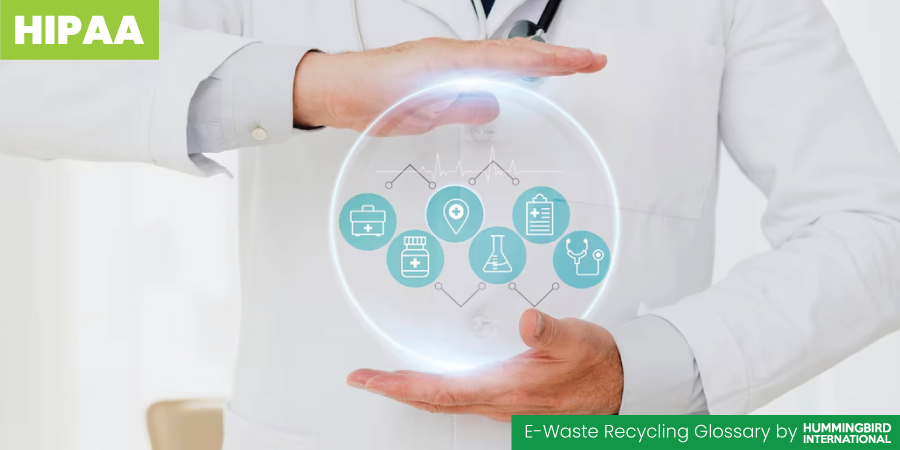
HIPAA or Health Insurance Portability and Accountability Act is a US legislation that safeguards data privacy and medical information in the health insurance sphere. It further aims to improve the workings of several branches of the health insurance industry as they deal with patient health coverage and data protection.
HIPAA becomes a critical legislation when cyber security threats resulting due to careless e-waste disposal become a reality or close to it.
33. Identity Theft
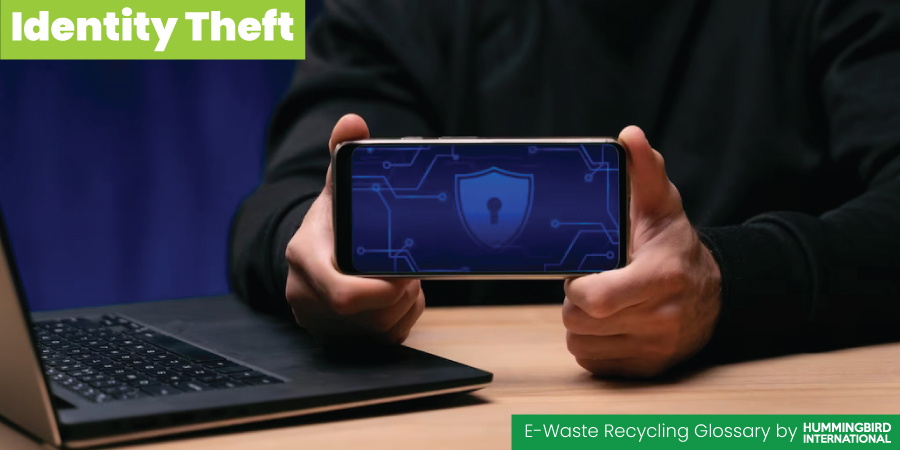
Identify theft is when someone steals your personal information, such as your name or personal identification details, including your social security number, bank account details, and credit card data. 33% of Americans have been the victim of identity theft crimes.
Identity theft is often done for financial gain, but can also include more malicious intentions like impersonating you online, using your financial details to commit fraud, taking somebody’s identity to hide their criminal records, etc.
Once again, poor e-waste management and recycling practices can make these thefts more common and convenient.
34. Incineration
It is the process of burning something at such high temperatures that it turns as much of it into ash and cinder as possible.
In the context of e-waste disposal, burning down old phones, laptops, tablets, and such results in the release of extremely toxic gasses and chemicals. If you are new to e-waste recycling, stay away from recycling guides or companies that use incineration as a part of their processes. It’s extremely harmful to the environment, so do your research before hiring an electronic waste recycling company to help you take care of your discarded electronics.
35. Information and Communication Technology Equipment — ICTs
ICTs are broad industry terms that encompass technologies used for acquiring, storing, processing, and communicating information. Common examples include computing systems (eg: word processors), software applications (eg: productivity suites), and communication networks (eg: the internet). Consumers electronics are also a subset of ICTs.
36. IT Asset Disposition — ITAD
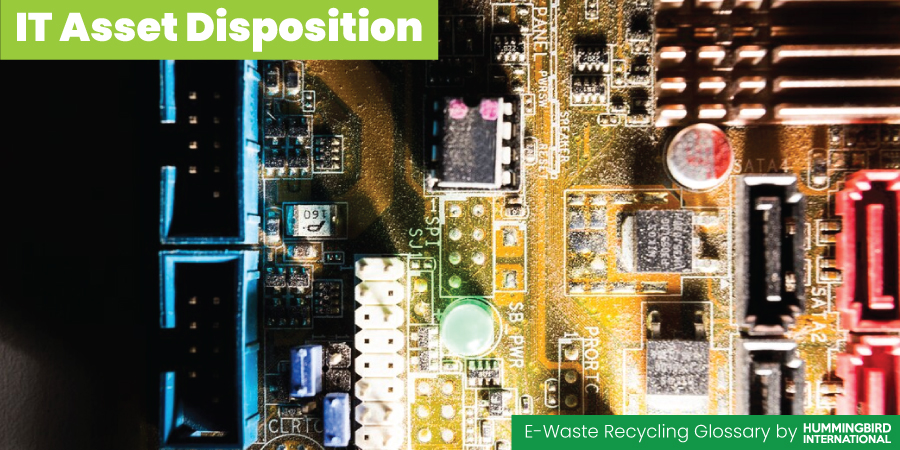
IT asset disposition or ITAD is an industry term that covers how IT-related waste can be disposed of most sustainably and responsibly. It involves repairing, recovering, reusing, refurbishing, and recycling old or discarded IT assets, and then disposing of the waste in an environmentally-friendly way.
We offer free e-waste recycling in NY, NJ, and PA for safe and secure ITAD for both residential and commercial consumers.
37. Landfills

Landfills are designated and maintained sites for the disposal of solid waste. Different types of landfills are used to handle different kinds of waste, including municipal solid waste, industrial waste, and hazardous waste.
Strict federal regulations oversee their operations and maintenance to ensure minimum environmental impact. Several states, including New York, New Jersey, and Pennsylvania, have banned e-waste disposal in landfills due to the extreme amounts of toxins these products release when decomposing.
38. Large HA
Large HA or large household appliances are a type of electronic waste. These include items such as HVAC units, refrigerators, freezers, washing machines, and more.
39. Light Fixtures
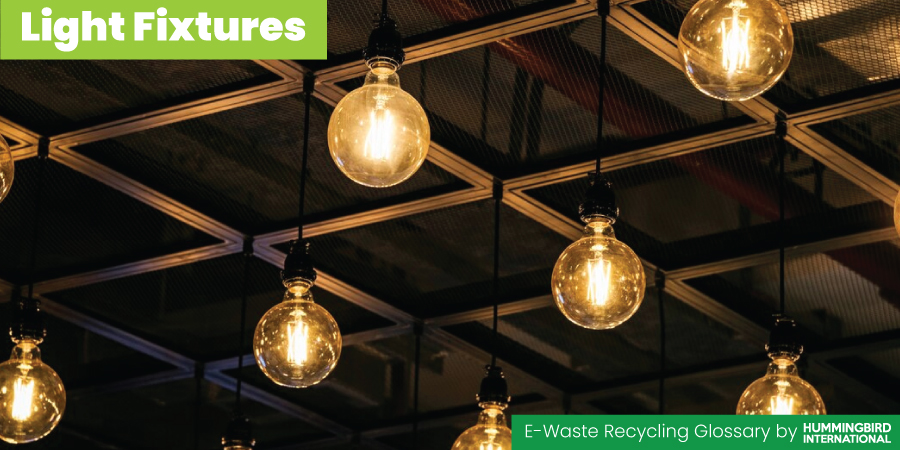
Light fixtures are another classification under electronic waste and include different kinds of lighting equipment, such as LED lamps, fluorescent lamps, switches, and others.
40. Lithium-Ion

These are rechargeable batteries and are commonly found in electronic devices such as laptops and smartphones. They are typically more expensive (initially) than alkaline batteries, but since they offer repeated cycles of recharging, they are cost-effective and better for the environment.
41. Medical Devices
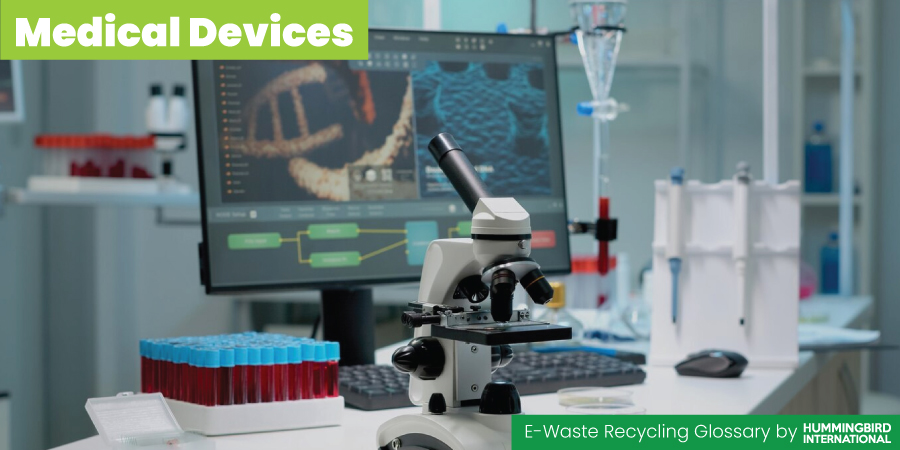
Medical devices that use electrical or electronic equipment or components are categorized as healthcare e-waste. Things like radiotherapy equipment, ventilators, freezers, and dialysis equipment, etc. belong to the medical e-waste category.
Our waste management recycling pickup schedule often lists healthcare facilities that are looking to dispose of their e-waste in the most responsible way possible.
42. Monitoring and Control Instruments — M&C
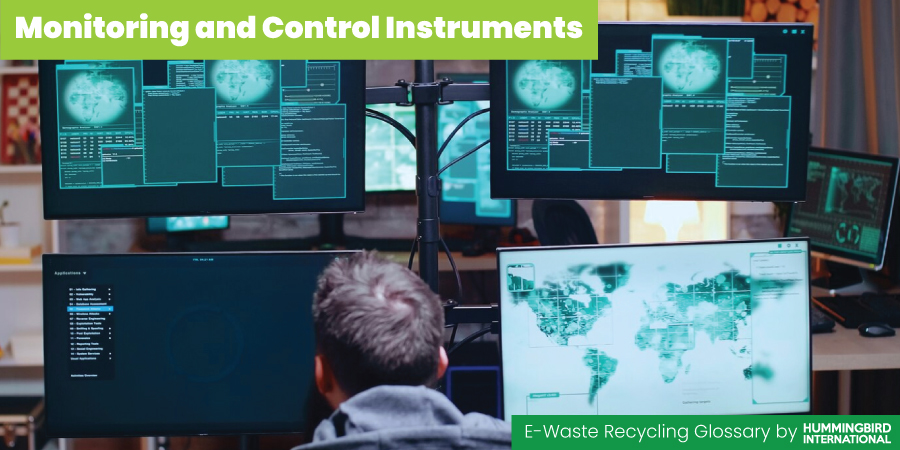
These are devices and instruments that we use to control and influence the environment around us. M&C instruments include thermostats, door or window sensors, security cameras plus dispensing devices such as water or coffee dispensers or ATMs.
43. National Institution For Standards And Technology — NIST
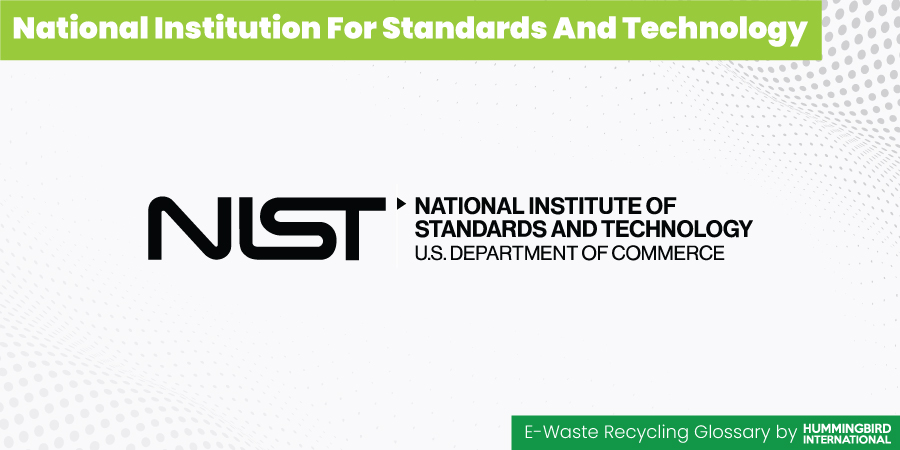
Image Source: nist.gov
NIST is an agency under the US Department of Commerce. It is tasked with the responsibility to keep America retain its competitive and innovative edge in the global economy. In the context of e-waste, NIST provides standards and guidelines to ensure secure data and software erasure.
Through methods like degaussing, NIST directs organizations to ensure that their sensitive data is not recoverable, even with the most advanced recovery tools available.
44. New York State E-Waste Disposal Ban
According to this ban, implemented on January 1, 2015, New York State residents are no longer allowed to dispose of certain types of e-waste items in trash, trash pickups, landfills, or waste-to-energy facilities.
These items can now only be sent to a registered e-waste recycling company, or an e-waste collection site, or given to takeback (or buyback) programs.
45. Nickel Metal Hydride Batteries

Also known as NiMH batteries, nickel-metal hydride batteries are a type of rechargeable battery, most often used as a substitute for non-rechargeable alkaline batteries. They have a high self-discharge rate, meaning they’ll lose their charge more quickly when not in use. Yet they are more economical and eco-friendly than some other options in the market.
46. Obsolescence
Obsolescence refers to the process of becoming old, obsolete, or outdated.
When talking about e-waste, obsolescence refers to a culture and intentional practice. Of making and manufacturing electronic goods (smartphones, most notably) in such a way that they’ll become slow or outdated after a couple of years, necessitating the buying of the latest device to access the latest technology.
Tech companies not only create this culture of obsolescence but also perpetuate it by opposing legislations that aim to equip users with the knowledge and techniques to repair their damaged IT products.
47. Pennsylvania Disposal Ban
The Covered Device Recycling Act in Pennsylvania bans the disposal of certain covered devices — cell phones, televisions, computers, tablets, and more — in the trash. These electronic waste items must either be sent to a registered e-waste recycling company or a collection site. Users can also explore takeback or buyback programs run by businesses like Target, BestBuy, and different tech manufacturers.
48. Recyclable Circuit Boards
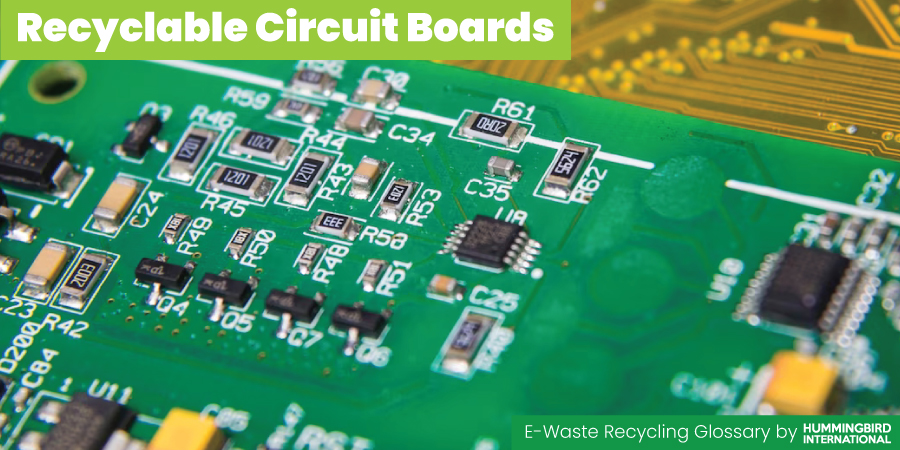
Traditional circuit boards (PCBs — printed circuit boards) are made with materials like fiberglass, epoxy, and copper. These materials can be recycled but the process is complicated and can be harmful.
Recyclable circuit boards are an innovative product. They are made with plants and are designed to fully biodegrade when at the end of their lifecycle. These new breeds of circuit boards have shown a high level of strength and performance, and we may soon see them in our electronic devices.
49. Refurbishing
Refurbishing is the process of cleaning up an old item and repairing it to work like new. Responsible waste management recycling uses refurbishment as a significant part of the process where old or discarded devices are cleaned up, repaired, recycled, and remade to function like new.
It reduces the e-waste directly and helps prolong the lifecycle of several different components within the product — sometimes the product itself.
50. Responsible E-Waste Handling
When we say responsible e-waste handling, it refers to a careful and comprehensive process of recycling electronic waste ensuring no harm to the environment whatsoever. By looking for innovative IT disposal solutions, responsible e-waste measures curb the problem at its source.
By demanding more sustainable ways to manufacture electronic products, product lifestyles can be prolonged and waste generation directly reduced.
51. Shredding

Once all the valuable and usable materials are separated from discarded electronics, what’s left is an unusable waste. That scrap is physically shredded through machines and turned into dust and debris to ensure complete data erasure. It also reduces the overall amount of the waste so it takes up less space when eventually sent to landfills.
52. Small HA
Small household appliances are a type of electronic waste category and cover items like hair dryers, toasters, electric shavers, and such. Our free e-waste recycling facility is a convenient way to get rid of any outdated small appliances you have lying around. Just give us a call — (888) 392-7839 — and schedule a free pickup.
53. Smart Sorting

Eco-friendly electronic waste recycling depends on accurate, efficient, and safe sorting of useful materials and components from useless scrap.
Smart sorting uses several kinds of advanced technologies to automatically segregate waste into categories — items that need a little repair, items that need to be broken apart to extract valuables from inside, and scrap that needs to be destroyed and either incinerated or sent to landfills.
Smart sorting allows e-waste recycling to become more efficient and sustainable.
54. Software Destruction
Software destruction is the process of permanently erasing all information from a software or storage device. It has three types:
- Overwriting: adding new data over the old one in the same physical space, by using random number sequencing to make the old data unreadable and inaccessible.
- Degaussing: damaging the magnetic strip of the storage device so the existing data is destroyed.
- Physical destruction: the most effective way of erasing data is by physically destroying and shredding the hard drive or other storage media to a point that it cannot be retrieved or put back together through any means and technology.
Software destruction is a necessary part of responsible e-waste recycling management.
55. The 4R Rule
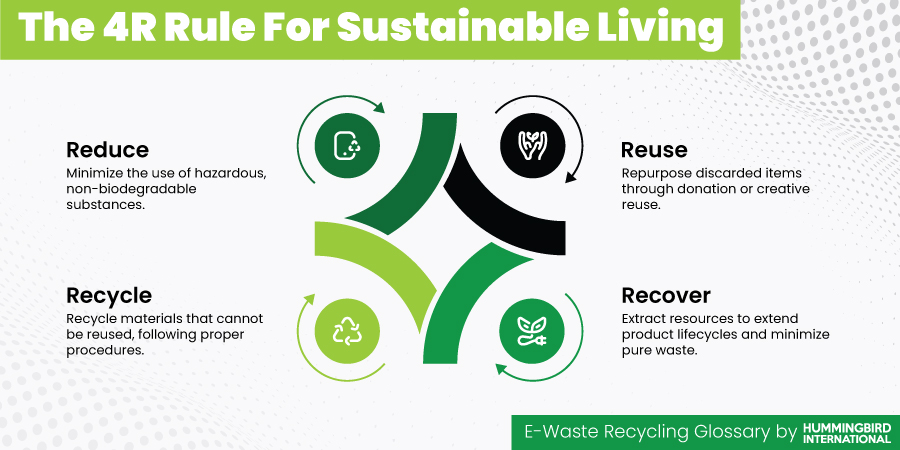
The 4R rule refers to the principles of Reduce, Reuse, Recycle, and Restore. This principle applies to waste management recycling strategies that are most environmentally sustainable.
It encourages consumers and stakeholders to:
- reduce the use of dangerous, non-biodegradable substances;
- reuse discarded items by donating them or exploring their creative utilization;
- recycle what cannot be reused and do it properly; and,
- recover what we can from the leftover garbage to ensure a long product cycle and a minimum amount of pure waste.
By using these ideals of sustainable use of technology, we not only create greener waste management recycling but nip the problem in the bud by generating less waste to begin with.
56. Toxic Heavy Metals
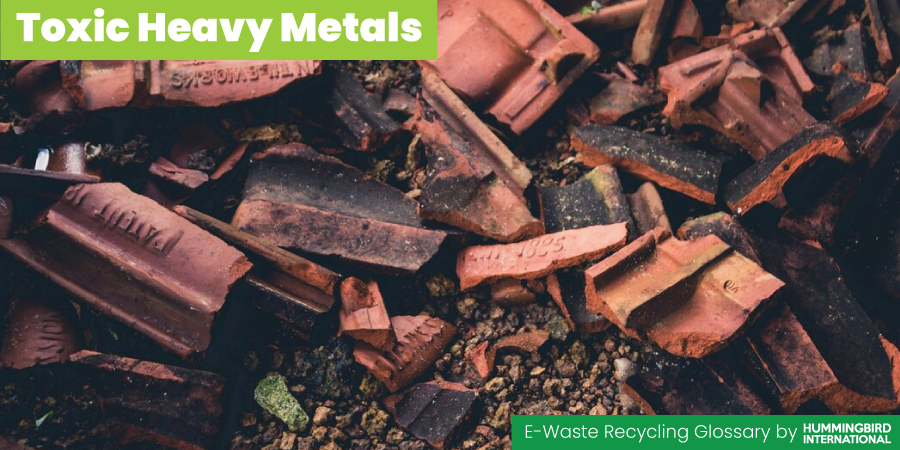
Toxic heavy metals include dense metals like arsenic, chromium, lead, and mercury. These are extremely hard to get rid of in the environment, and when disposed of in landfills, release toxic gasses and waste streams that pollute the land, water, and air.
Unfortunately, our everyday electronics like smartphones are made with these metals and thus need to be sent to proper waste management recycling bins facilities.
57. Toxic Waste
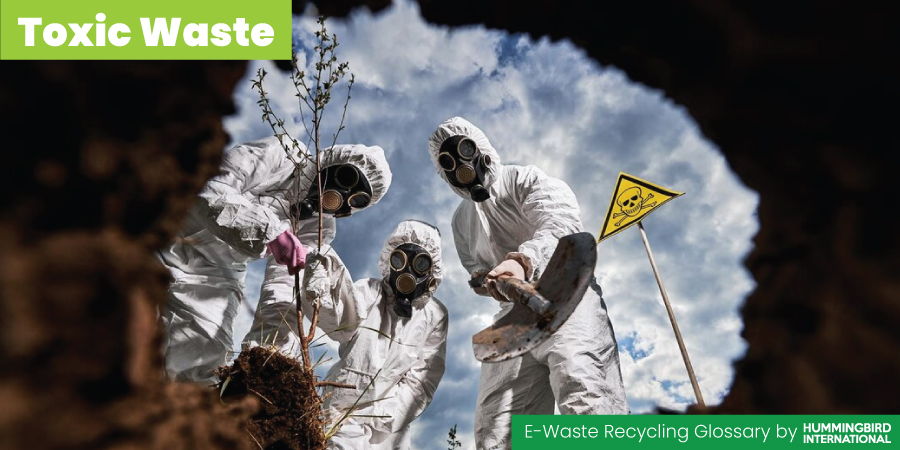
Waste is considered toxic when it poses harm to humans, animals, plants, and the rest of the environment.
Electronic waste is considered the fastest-growing toxic waste stream in the world because so many of our consumer electronics and digital devices are made with toxic metal components that are dangerous to decompose and complicated to recycle.
58. Toxins
Toxins are harmful chemicals found in toxic metals such as lead, mercury, and nickel as well as in organic compounds like flame retardants.
59. Waste Electrical And Electronic Equipment — WEEE
WEEE is the European Union’s directive framework that sets guidelines for the collection, sorting, treatment, and recycling of electric and electronic waste material within the EU.
60. Zero Waste
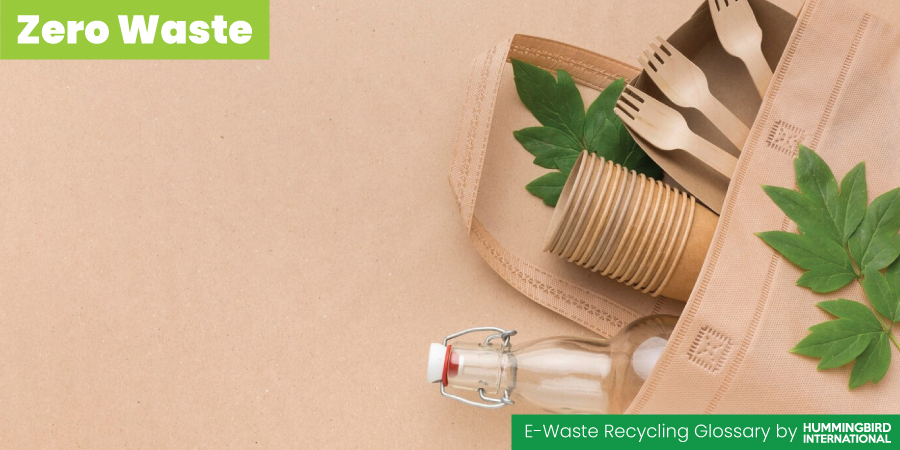
The concept of zero waste describes a responsible means of production and consumption where products and materials are constantly recovered, repaired, and reused to prolong their lives to the fullest. It also encompasses the disposal process by ensuring that waste is not burned or disposed of on the land or sea, or in any other way that threatens human or environmental life.
By living a zero-waste life, we live more consciously — aware of our actions and their impact on the environment.
Conclusion
To deal with a problem most effectively, it’s critical to understand the language that surrounds it. Through this A to Z recycling guide about e-waste vocabulary, we aim to equip eco-conscious consumers to become familiar with common terms and terminologies that exist within the electronic waste culture.
It will help you identify materials, processes, and practices that complicate this problem. It will also help you look for ideas, solutions, and technologies that can resolve this problem and create a greener and healthier planet.
Image Source: Freepik.com
About The Author Kelly Sampson
Kelly Sampson is a writer, blogger, and environmental enthusiast. She has strong opinions about climate change, the dogs vs. cats debate, and Oxford commas. She has lent Hummingbird International her engaging and spirited voice and turned our blog into a great place to find valuable information about e-waste, e-waste recycling, and the ITAD industry. Explore our blog to read more of her work.






